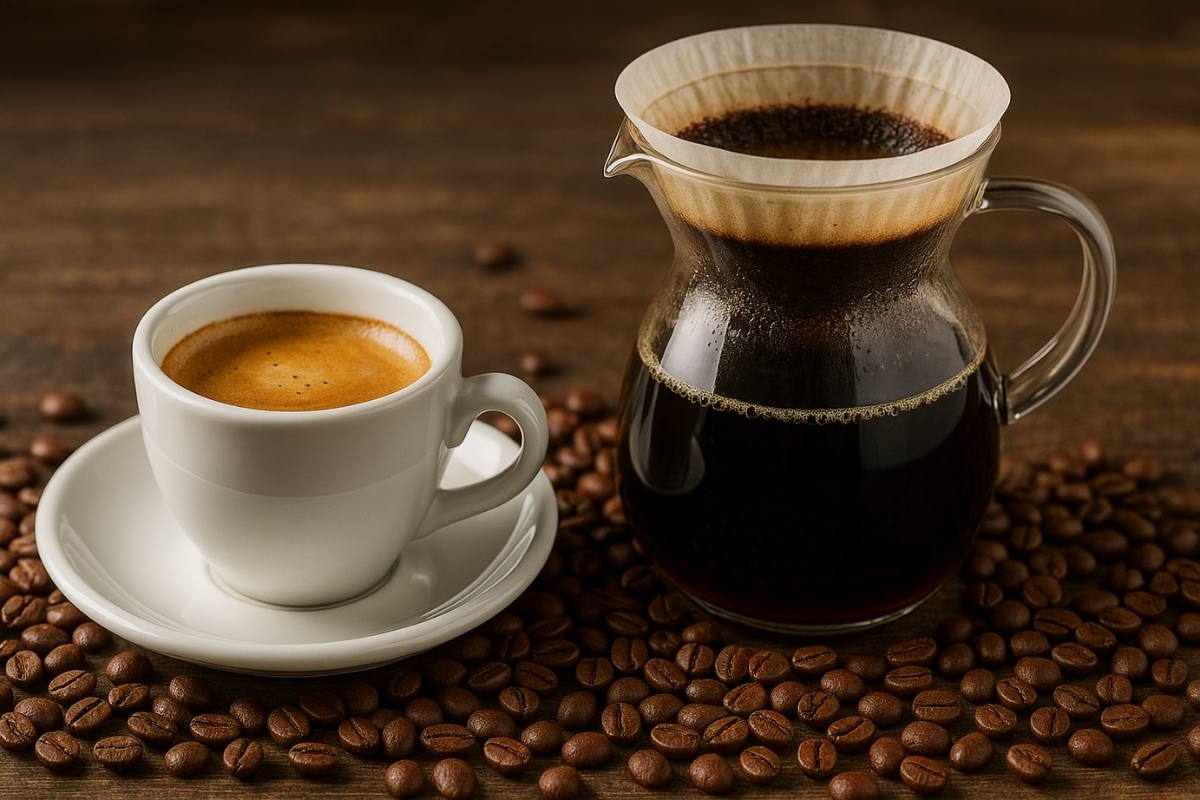Coffee lovers often find themselves choosing between two of the most iconic brewing methods: espresso and filter coffee. While both originate from the same beloved bean, the methods behind their preparation—and the resulting flavor, texture, and experience—are vastly different. In this article, we’ll explore everything you need to know about the differences between espresso and filter coffee.
What Is Espresso?
Espresso is a concentrated form of coffee brewed by forcing hot water through finely-ground coffee under high pressure. It originated in Italy and is the base for many café drinks like cappuccino, latte, and macchiato.
Key Characteristics:
- Brew Time: 25–30 seconds
- Grind: Very fine
- Brewing Pressure: 9 bars (130 PSI)
- Caffeine Content: About 63 mg per 1 oz shot
- Flavor: Intense, bold, with a thick crema on top
What Is Filter Coffee?
Filter coffee, also known as drip or pour-over coffee, is brewed by letting hot water slowly pass through coffee grounds via gravity. It’s a popular brewing method in homes and cafés around the world and offers more subtlety in flavor.
Key Characteristics:
- Brew Time: 3–5 minutes
- Grind: Medium-coarse
- Brewing Pressure: None (gravity-based)
- Caffeine Content: About 95–120 mg per 8 oz cup
- Flavor: Light to medium body, clean, nuanced
Brewing Equipment Comparison
| Feature | Espresso | Filter Coffee |
|---|---|---|
| Equipment Needed | Espresso machine, grinder, tamper | Pour-over setup, drip machine, filter |
| Cost | High | Low to moderate |
| Skill Level | Moderate to high | Beginner to intermediate |
| Portability | Low | High (especially with manual methods) |
Flavor and Texture Differences
One of the most noticeable differences between the two lies in taste and mouthfeel.
Espresso:
- Flavor: Strong, concentrated, and often bitter.
- Texture: Creamy due to the emulsification of oils under pressure.
- Aroma: Intense and immediate.
- Finish: Lingering and heavy.
Filter Coffee:
- Flavor: Complex and layered. You can taste fruity, floral, nutty, or acidic notes.
- Texture: Thin and clean.
- Aroma: Delicate and subtle.
- Finish: Light and crisp.
Caffeine Comparison
There’s a common myth that espresso has more caffeine than filter coffee. The truth is more nuanced.
- Espresso: Higher caffeine per ounce.
- Filter Coffee: Higher caffeine per serving, since it’s typically consumed in larger volumes.
Example:
- 1 shot of espresso (1 oz): ~63 mg caffeine
- 1 cup of filter coffee (8 oz): ~95–120 mg caffeine
When to Choose Espresso
Espresso is ideal when:
- You want a quick, strong dose of coffee.
- You enjoy milk-based drinks like lattes or cappuccinos.
- You prefer bold, intense flavors.
- You have the equipment and time to master the technique.
When to Choose Filter Coffee
Filter coffee is best when:
- You want to enjoy a longer, smoother coffee experience.
- You prefer lighter and more complex flavors.
- You’re looking for convenience and affordability.
- You want to highlight the unique notes of specialty beans.
Cultural Differences
Espresso Culture:
- Deeply embedded in European countries like Italy and Spain.
- Often consumed quickly at a café counter.
- Focused on tradition and technique.
Filter Coffee Culture:
- More popular in North America, Scandinavia, and Japan.
- Often enjoyed slowly, especially during breakfast or while working.
- Encourages experimentation with brewing methods and beans.
Brewing Time and Ritual
The brewing process can greatly affect how you experience your coffee:
- Espresso: Fast, mechanical, and intense. Brewing is part art and part science, involving pressure, timing, and precise dosing.
- Filter: Slow and meditative. Pouring water in spirals and waiting for extraction turns coffee into a mindful ritual.
Health and Nutrition
Both drinks contain antioxidants and other compounds beneficial to health, but there are small differences:
- Espresso: Contains more oils and may be harsher on sensitive stomachs.
- Filter Coffee: The paper filter traps most oils (cafestol and kahweol), which may be better for cholesterol levels.
Environmental Impact
- Espresso Machines: Use more electricity and often disposable pods (if using capsule systems).
- Filter Coffee: Lower energy use, especially with manual methods like pour-over or French press. Filters can be compostable.
Which Is Better?
There is no universal “better” method—it depends entirely on what you value most in your coffee.
| Preference | Go For |
|---|---|
| Speed and intensity | Espresso |
| Complexity and clarity | Filter Coffee |
| Portability and simplicity | Filter Coffee |
| Café-style drinks | Espresso |
Final Thoughts: Two Roads to Coffee Perfection
Whether you’re an espresso aficionado or a filter coffee devotee, both brewing styles offer something beautiful and satisfying. Understanding their differences allows you to appreciate what each one brings to the cup—and to your daily routine.
In fact, the best coffee experience might just be alternating between both depending on the day, the mood, or the bean in your hand. Either way, the journey into coffee mastery becomes more rewarding with every sip.
Agora vou gerar a imagem horizontal ultra realista referente a esse artigo. Em seguida, continuo com o próximo da lista: “How to Store Coffee Properly and Preserve Its Flavor.”
